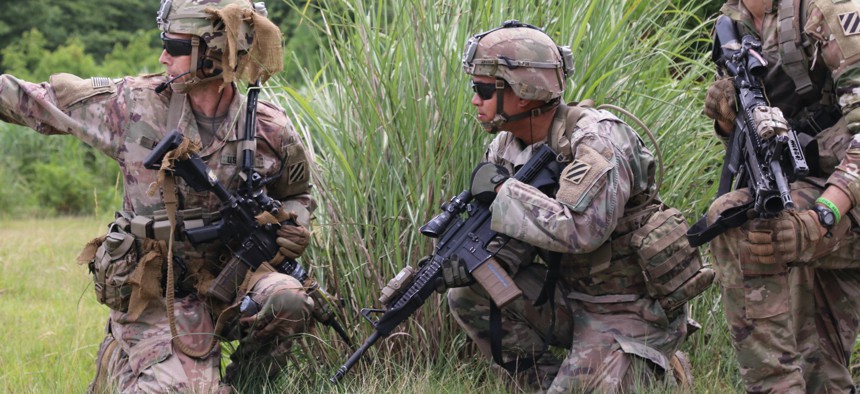
U.S. Army soldiers of the 3rd Infantry Division set up security after dismounting a UH-60 Black Hawk on Aibano Training Area, Japan, Jun 28, 2021, as part of exercise Orient Shield. Army / Spc. Summer Keiser
Army Would Have 5 ‘Core Tasks’ in a Pacific Conflict
Secretary Wormuth said the service is keenly watching U.S. talks with regional allies over access to bases, including for new weapons.
The Army will have five “core tasks” in an Indo-Pacific conflict, which it can accomplish without a dramatic expansion of its permanent presence, Army Secretary Christine Wormuth said Wednesday.
The first task will be securing and establishing joint bases and staging areas for air and naval forces, Wormuth said during an event on China’s power with the Center for Strategic and International Studies. It will also be prepared to provide “integrated air and missile defense” and quick reaction forces.
This makes the Army the “linchpin service” for the joint force, she said, implicitly shrugging off perceptions that the service plays second fiddle in the region.
In its second task, the Army will operate much of the backbone of a secure communication network and create supply chain networks to forces distributed throughout the region. It will also maintain stockpiles of munitions and forward arming and refueling points.
The Army will also help synchronize, sustain, and defend operations through a scalable joint headquarters as its third task, Wormuth said.
The fourth task is providing ground-based fires such as hypersonic weapons, a mid-range missile, and precision strike missiles, all three of which will begin fielding in 2023, Wormuth said. Those weapons would likely initially be based in U.S. territory, but the State Department and the Pentagon are talking to close allies about overseas locations.
“We will be able to interdict fires across sea lines of communication, suppress enemy air defenses, and provide counter fires against mobile targets,” she said.
The Army’s fifth task, if required, will be to counterattack with infantry and aviation “to restore the territorial integrity of our allies and partners,” Wormuth said.
As well, any conflict in the Pacific can be expected to include cyber attacks on critical infrastructure back in the United States. The Army would support civil authorities as they would during a natural disaster, though the scale of cyber attacks would be much bigger, she said.
The recently approved 2021 Global Posture Review emphasized building relationships with regional partners and allies and supporting infrastructure improvements, areas the Army has been focusing on for years. The Army has relationships with regional armies that its sister services do not have, Wormuth said.
Don't miss:
The review is also making the Army think about more opportunities for using its prepositioned equipment and supplies more efficiently, she said.
The Army has forces in South Korea, Japan, and Guam, all supported by commands and units based in Alaska, Hawaii, and Washington state. But Wormuth said the Army is keenly interested in discussions being held by Pentagon and State Department officials about more access and basing arrangements.
“The United States’ military footprint in the theater has been heavily oriented towards the Northeast part of the region, and I think there is very much a desire to be able to expand our access and basing arrangements more into Southeast Asia, because if we were able to do that, we would have a more dispersed posture that would give us much more flexibility,” she said.




